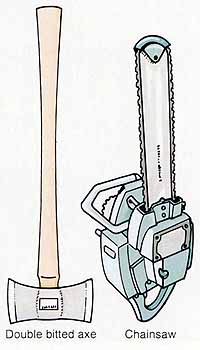If you cut your own wood instead of buying it, do so six to nine months before you expect to burn it, to give it time to season. Cut the wood in spring and fall, when the weather is pleasant and in sects are dormant.
The preferred tools for cutting wood are the double-bitted axe and the chainsaw.
• Double-bitted axe: A middle-of-the-road double-bitted axe weighs about three pounds; a light one weighs as little as two pounds; and a heavy one weighs as much as four pounds. Axe handles run from about 24 to 30 inches long. In contrast to a single-bitted axe, a double-bitted axe gives you two tools in one. You can keep one of the two blades honed extremely sharp for felling and limbing trees, and the other blade honed slightly blunter for cutting roots, slashing small branches from a fallen tree, or splitting logs.
In general, choose an axe whose heft is slightly heavy, and whose handle reaches to the top of your thigh or a little higher, when the axe is standing on its head. But if you plan to do extensive chopping—felling trees or cutting through logs the size of a telephone pole for instance—buy the heaviest axe with the longest handle you can swing in a comfortable rhythm. The heaviness and length combined will let the axe do a large portion of the work, and allow you to swing it for a maximum amount of time with a minimum of effort and discomfort.
Technique is important when you’re swinging an axe. Take a comfortable position in front of your wood and grasp the axe a couple of inches up from the end of the handle—not with one hand toward the heel and the other halfway toward the head. Look at the spot you want to strike; place the blade there; swing the axe back and up; and let it fall to its target. After a few cuts—when you’ve discovered that you don’t have to drive the axe down, but that you only have to bring it up and guide it the rest of the way—you’ll begin to find an easy, natural rhythm that will allow you to cut far more wood in any given period of time, and cut for far longer, than you can if you work at it.
All the axe lore in the world won’t help you if your blade is dull, however. Not only will a sharp cutting edge make your job easier, it will also make your job as safe as possible, since it is the dull blade that glances off the log, and the sharp one that bites.
To sharpen an axe use a file or rasp to smooth the inevitable nicks, coat the edge of the blade with a drop or two of oil, and use a hand-held hone or sharpening stone that has at least two grades of grain for coarse and fine honing. Move the stone in a circular motion along the blade edge, being sure to maintain the original bevel. This is not a complicated job, but it takes time and more effort than the new wood chopper may expect. Take the time and make the effort; the energy you save will be your own.

Double bitted axe; Chainsaw
• Chainsaw. Chainsaws range in size from about 6 to 15 pounds. If you plan to do a lot of cutting, you can justify buying a heavier chainsaw, since it will make your work go much faster and easier. Of course, heavier saws are harder to hold and require more strength to use. If you expect to cut only one cord or less per year, a smaller, lighter saw will do just fine. The light ones are relatively easy to use, and they will take down small trees.
Chainsaws come in both electric- and gas-powered models. An electric saw is less expensive, but you may need to buy a portable generator to go with it, and the generator will make the cost considerably greater than that of a gasoline saw. Electric saws tend to be lighter, and are more useful for smaller jobs.
Good chainsaws cost anywhere from $140 to $900, depending on the size, quality, manufacturer, and where you buy it. It’s best to buy your saw new rather than used—that way you can be certain what kind of upkeep it receives from the be ginning. You may prefer a particular brand of saw, especially if you’ve read reports on the various brands or have tried out a variety of saws. But if your winter heating depends to any degree on your ability to cut wood, buy a saw that can be serviced locally.
The chainsaw is a powerful tool, and it can be extremely dangerous if it is mishandled. So always work slowly, mindfully, and carefully, and always low the manufacturer’s instructions for use, care, and maintenance.
Next: Felling Trees
Prev: Wood as Fuel